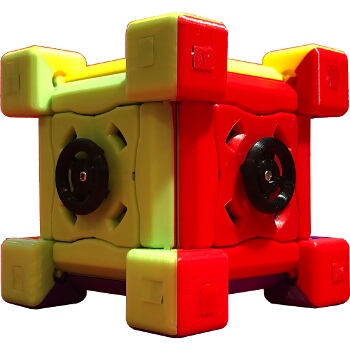
Above:View 1
Click a thumbnail to see its larger version and description.
The simplest possible edge turning cube implemented in an extremely strange mechanism.
This puzzle works by turning the "airlock" handles to either fully lock a face, or attach it only to a single edge, allowing that face to turn.
Each face has an "outside" and "inside" to it, the full colour face is "outside", and the inverted (black face, coloured handle) is the "inside". solving the puzzle involves getting all the faces back where they belong, and with the correct side "out". An alternate solve is to do the same, but with each face "inside out".
The puzzle is quite easy, since each move only affects 1/3 of the pieces.
It could be made more difficult by requiring the edges to be solved as well. The designer set this version up so that no matter what, the edges always stay "solved", but making the edge rotors be a solid colour would change this quite a bit, and he assume make the puzzle significantly more difficult to solve.
Ever since creating "airlock 20" (see the separate entry), the inventor thought of a way to make a puzzle where one swaps pieces by turning them around a shared edge. The inventor wanted to come up with a mechanism that prevented "cheating".
Finally the inventor came up with such a mechanism, and designed it in a cube shape this time, hence Airlock "6". The basic idea is that there are latches sticking out of each face, that slide into grooves in the "edges" of the puzzle, and then turn to lock in place, holding the face securely. By turning them 90 degrees you can re-open that face to movement. There is a handle on the center of each face, and when you turn it, the latches on all sides turn together (via gears).
To make it work, the inventor added a selector ring on each face, which when turned selects *1* edge to NOT turn when you turn the handle. this way, you can pull the face out and rotate it around *1* edge of the puzzle. If you do this for 2 adjacent pieces, you can spin them around and swap them.
The first version of this puzzle can be seen in image 7 and ended in a tragedy since it melted in the sun after assembly. The inventor subsequently made the version shown in images 1-6 with a simpler mechanism.
Links

Contributors
Thank you to the following people for their assistance in helping collect the information on this page: David Pitcher.
Collections
No one has added this puzzle to a collection yet!
Found a mistake or something missing?
Edit it yourself or
contact the moderator.







